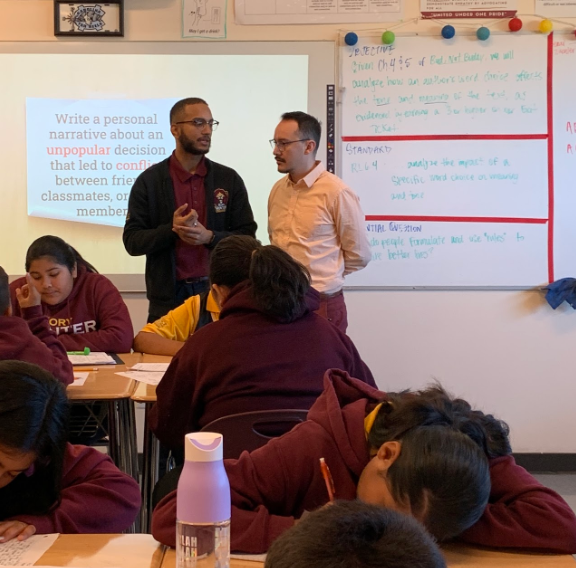Alliance Kory Hunter Middle School adapts a co-teaching model for distance learning with successful results for scholars and teachers.
Upon reviewing Alliance Kory Hunter Middle School academic data a few years ago, Principal Omar Reyes found that the needs of the most vulnerable population of scholars––English Learners and Students with Disabilities––were not fully met. He called on sixth grade ELA teacher Daniel Helena (a 2020 Teacher of the Year Finalist) and Resource Specialist Salvador Limón––veterans of the co-teaching model––to pilot co-teaching during the 2018-19 school year. The results were so successful that in the 2019-20 school year, Principal Reyes incorporated co-teaching models in ELA and math classes across all grade levels.
In March, all school campuses closed due to health concerns around the COVID-19 pandemic. In only a few weeks, teachers at Alliance Kory Hunter pivoted not only to provide Distance Learning but also to maintain a modified co-teaching model.
For example, Mr. Helena produced weekly on-demand videos outlining the lessons for his scholars, and Mr. Limón provided feedback on necessary accommodations for scholars with disabilities. “Mr. Limón can put himself in the position of students with varied needs and analyze how the content can be more accessible and what potential pitfalls students with special needs might have,” explained Mr. Helena. “I cannot emphasize the benefit of him revealing my blindspots enough. We can always improve. That’s what makes education an art––reacting and responding to students.”
The co-teaching model has not only been beneficial for scholars during Distance Learning but for the teachers, as well. “Our weekly check-ins remind me that we still have each other’s backs. I feel less alone and more validated as an educator,” shared Mr. Limón.
Mr. Reyes added that “Having multiple skilled adults teach a section has a tremendous amount of upside. From a social-emotional standpoint, students have another adult that they can connect with. By having a resource specialist in the class you are also able to ensure that differentiation is happening from bell to bell. Planning, teaching, and assessing is rooted in equity, which ensures scholars can be successful. In Distance Learning, this looks a little different, but the resource specialist is still working with the general education teacher to ensure that we are being mindful of not only the skills gaps that exist but also students’ home lives.”
Mr. Helena and Mr. Limón shared a set of guidelines for co-teaching both in and out of a Distance Learning environment:
- Demonstrate mutual trust and respect, including playing on each other’s strengths and viewing each other as equals in the classroom.
- Establish shared values to reduce conflict.
- Provide additional emphasis on school community/connection, including parental involvement.
- Ensure buy-in from staff, including opportunities for Professional Development, observation, and participation in the hiring process.
- Implement based on the needs of the school community, not because co-teaching is the current educational buzzword.







